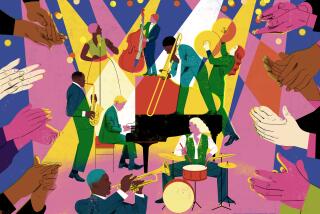Bessie Smith’s Legacy Now Shapes Concert Hall
- Share via
CHATTANOOGA, Tenn. — Bessie used to thrill me at all times. It’s the way she could phrase a note in her blues, a certain something in her voice that no other singer could get.... --Louis Armstrong
They’re playing a new song here and this one isn’t about choo-choos. In September, the city will open a concert hall dedicated to the “Empress of the Blues,” Bessie Smith.
A dilapidated brick newspaper warehouse is being transformed into the Bessie Smith Hall, a 14,500-square-foot performance hall/supper club and new home for the Chattanooga African American History Museum. Organizers are about to see their 10-year dream come true, after overcoming local opposition to a “cabaret” in this buckle of the Bible Belt.
“The supper club will be decorated to the period and style of the clubs Bessie Smith sang the blues in during the ‘20s and ‘30s,” says its director, Countess Jenkins. The 260-seat club will feature nightly house bands as well as regional and national blues and jazz musicians.
Jenkins’ entertainment list reads like a who’s who of blues. She hopes to attract such talent as John Lee Hooker, Albert Collins, Johnny Copeland, Son Seals and Lonnie Brooks--not to mention superstars B.B. King, Ray Charles and Aretha Franklin, who frequently credits Bessie Smith’s contributions.
In addition to the concert schedule, organizers envision touring exhibits by black artists as well as a permanent exhibit on the history of blues. There are also plans for a cultural arts center with an arts school, youth orchestra, dance theater and a Bessie Smith record label.
“There is potentially a Whitney Houston living in Macauley Homes, Chattanooga’s biggest housing project,” says Jenkins. “Without the Bessie Smith Hall, she will never get the training needed to go on.”
Smith had no such help. From her childhood days in a one-room shack in Chattanooga, she began her career singing for nickels and dimes on the city’s street corners. It was there that Ma Rainey discovered the gifted 18-year-old and took her on tour, as did “Georgia Tom,” Thomas A. Dorsey, father of modern gospel music.
While they influenced the young singer’s musical style, it wasn’t long before she developed her own sound. Her first record, “Downhearted Blues” sold an unheard of 750,000 copies its first months. People lined up for blocks to see her perform and white radio stations broadcast her shows. Through sheer determination and raw talent, she became the highest-paid black entertainer of her day.
“Bessie Smith invented herself,” jazz historian Rosetta Reitz writes in “Notable Black American Women” (Gale Research, 1991). “What sounds like improvising is the result of hard work and an understanding of the infinite possibilities of invention. Her moans and groans and slurs and swoops, scoops and slides (sometimes down a whole octave) and stretches were as carefully employed as each stroke on a master’s canvas.”
Though Smith’s career was cut short at age 43 by a car accident, she left a legacy of 160 songs including classics such as “St. Louis Blues” “Careless Love” and “Backwater Blues.” Her bright contralto and powerful stage presence influenced future greats such as Franklin, Billie Holiday and Patti LaBelle.
People are still lining up each summer for the Bessie Smith Strut, an annual blues romp held in conjunction with Chattanooga’s Riverbend Festival. It’s fitting that the Hall should be located on the same street as the Strut, where Smith sang and performed in the Blue Goose Hollow and Liberty theaters.
“Martin Luther King Boulevard has traditionally been the heart and soul of the black community,” says Russell Linnemann, University of Tennessee professor and host of a weekly blues radio show. “The Bessie Smith Hall should help revitalize the area and provide many more opportunities for blues artists.” Its debut seems especially timely as this music continues to gain popularity. “When Coca-Cola and Levi’s start using blues to sell their products,” adds Linnemann, “you realize that the art form has truly hit the mainstream.”
More to Read
The biggest entertainment stories
Get our big stories about Hollywood, film, television, music, arts, culture and more right in your inbox as soon as they publish.
You may occasionally receive promotional content from the Los Angeles Times.










